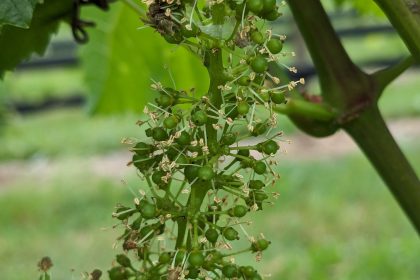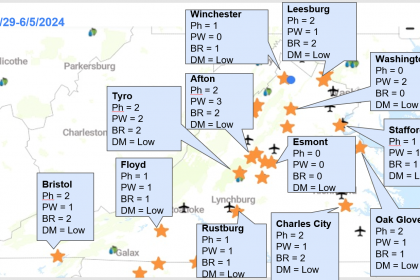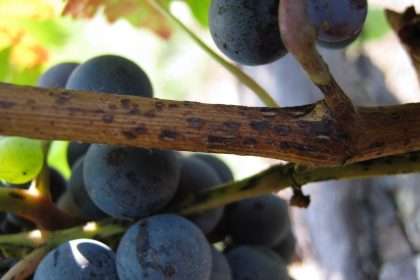As of today, it is about 10% bloom at our Chardonnay plots. Since bud break was about 2 weeks ahead of a typical year, things are moving along as we would expect. Of course, bloom in VA almost always has to happen in rain…
As for bloom time disease management consideration, please refer to the previous post.
From this point on, 4 to 5 weeks will be a critical period for management of downy mildew, powdery mildew, and black rot. Please make sure to keep your vines covered. Once again, providing a protection is much better and easier than playing a catch-up, especially if it comes to grape disease management in VA.
You can use protective materials such as mancozeb, copper, and sulfur as your backbone, and add more specific (and often locally systemic) materials. Some of these materials have efficacy against multiple diseases (either by itself or through the combination of two materials). Examples are
- DMI, aka SI (FRAC = 3), e.g., Rally, tebuconazole, Mettle, etc. Inspire super is a mixture of difenoconazole (FRAC 3) and cyprodinil (FRAC 9).
- QoI (aka strobilurins, Abound, Flint, etc., FRAC = 11),
- SDHI (Luna Experience (FRAC 7 + 3), Aprovia and Kenja (FRAC = 7), Pristine (FRAC 7 + 11), etc.)
Other disease-specific materials include:
- for Downy mildew: Revus and Forum (FRAC = 40), [note: Revus Top is a mixture of Revus and difenoconazole (FRAC = 3)], Zampro (FRAC 40 + 45), Ranman (FRAC = 21), Phosphites (aka Phos acid, Prophyt, Phostrol, etc., FRAC = 33), etc.
- for Powdery mildew: Quintec (FRAC = 13), Vivando (FRAC = U8), Torino (FRAC = U6), etc.
Why am I listing all FRAC codes? Because it is very important for you to rotate these FRAC codes to avoid fungicide resistance development. Please do your best to limit the use of a FRAC code (with exceptions of FRAC codes start with M) to 2 times per season.
Some people prefer to use captan as one of backbone materials. One thing you need to remember is that captan does not have much efficacy against black rot. Thus, if you use captan, you should mix with either FRAC 3 or 11 material for black rot management. Also, please remember that you cannot use captan with an oil because the combination will cause toxicity to grapevines.
Please refer to our pest management guides, which you can find on the right-hand side of this blog under “resources” for more information.







Mizuho, I ask myself this question every year. Reading the Pristine label, it states a 120 hr (5 day) REI for all cane-tying, cane-turning, or cane-girdling. Otherwise it is 12 hrs. Aside from differences in definition, when is a shoot a cane? Are we talking late season when the shoots have fully lignified? Using Pristine now, does this prevent me from returning to do shoot positioning, leaf pulling, and other canopy work for 120 hrs? Thanks!
Hi There,
Technically speaking shoots become canes when they are lignified. Thus, if you are very particular about the rule, all the activities listed on the label may not be applicable. However, there is reason(s) for the long REI, and thus, I feel that it is probably safer to follow the 5-day REI for other vineyard activities. (Unless the REI was set with a wrong reason, which can happen too!)